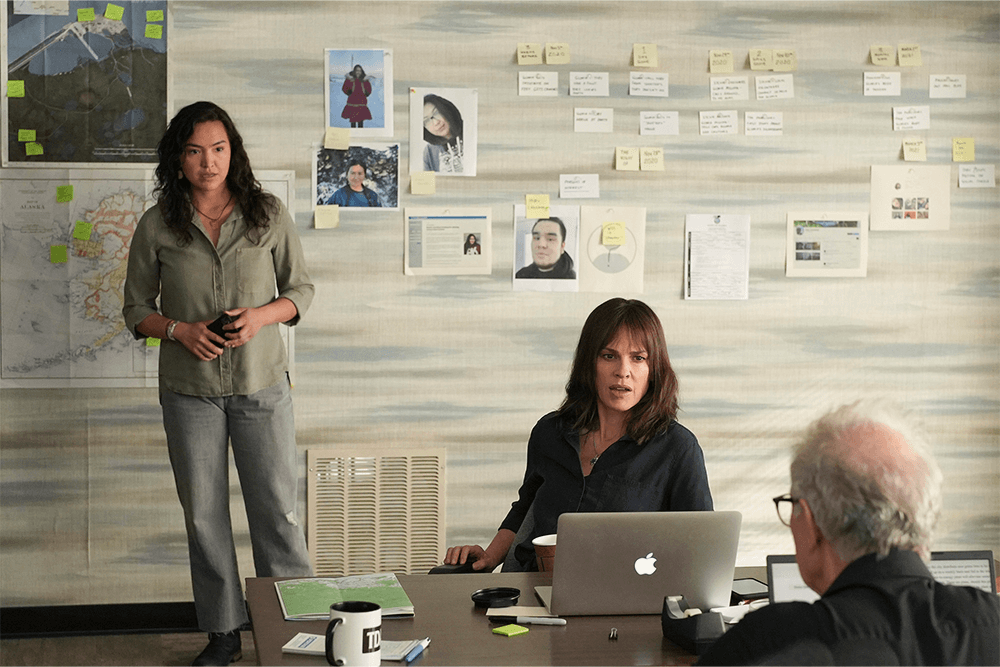
I don’t often turn on a non-news network television show and expect to learn. Instead, I expect to laugh, maybe cry (I’m looking at you, This Is Us), see loads of inaccurate depictions of medical interventions, or simply be entertained. But ABC’s new primetime drama Alaska Daily has me expanding my perspective on the possibilities of network TV. And that’s thanks to the light it’s bringing to a dark truth: the crisis of missing and murdered Indigenous women.
This grave reality becomes the focus of the show’s protagonist, investigative journalist Eileen Fitzgerald. In the aftermath of a professional fall from grace, Eileen, brilliantly portrayed by two-time Academy Award winner Hilary Swank, receives a request from a former editor to come to Alaska to investigate the death of a young Indigenous woman and tell the larger story of how non-Native communities and — alarmingly — the police are ignoring this crisis.
Created by Tom McCarthy, co-writer and director of the Oscar-winning film Spotlight, Alaska Daily is based on a 2020 Pulitzer Prize winning news series “Lawless” by the Anchorage Daily News and ProPublica, which investigated the prevalence of sexual violence in Alaska, systemic issues, and why the problem wasn’t getting better. This crisis is the central storyline, but McCarthy also features the complexities of the local news scene and the lives of the journalists who make local news happen.
In the late 2010s, I remember seeing displays in the quad of my college campus to raise awareness about missing and murdered Indigenous women (MMIW), but until Alaska Daily, I’d never heard this crisis mentioned on major platforms, news or otherwise—even though Indigenous communities, especially Indigenous women, have been speaking about it for years. It feels massive that this topic is now center stage on a highly promoted series on a national broadcast network starring Hilary Swank. While I can certainly validate the discomfort and/or disappointment some may feel about a show on this topic being led by a white woman, I can also recognize the shrewdness of this move. Swank as the headliner has the potential to attract a broader audience, including individuals not particularly invested in learning about this subject.
And, if the episodes that have aired so far are any indication, this show is truly invested in educating audiences on this issue and others impacting Indigenous communities. Most episodes end with a quotation from the 2022 Violence Against Women Act informing viewers that “in some areas of the United States, Native American women are murdered at rates more than 10 times the national average,” along with a call for the end to this injustice and a link to learn more. It’s an important way to remind audiences that, while the stories featured in the show are fictional, the crisis is very real.
The show, whose writers include two Alaska Natives — Andrew Okpeaha MacLean (Iñupiaq) and Vera Starbard (Tlingit/Dena’ina Athabascan) — also does a good job introducing its audience to aspects of life in Alaska Native communities, like the tradition of sharing hauls of food with family, immediate and extended, in the winter, or how moving to a new area often involves moving one’s physical house too. Minus a clumsy attempt to include a statistic about Indigenous suicide rates, which felt more like a line from a public service announcement than realistic dialogue, the writers have done a good job of revealing these community insights as they become relevant to the case investigation, making the inclusion of such details more organic.
Rosalind “Roz” Friendly, a local Alaska Native woman and investigative reporter at the Alaska Daily, is the character who often reveals these insights. Played by Grace Dove, who some may recognize from The Revenant, Roz finds herself partnered with Eileen on the case investigation, an arrangement neither is keen on. While Roz’s approach is informed by her cultural insight as a member of the Indigenous community, Eileen’s approach is informed by her ego and colonial mentality. She has no consideration for the differing social environment or cultural expectations, and refuses to defer to Roz’s expertise, not understanding that her own “tried and true” approach could alienate the community and impede the investigation.
Even though she’s out to find the truth, Eileen fails to understand that doing so in a way that disregards the people and traditions of the community in crisis is a quick road to more harm than help. One wouldn’t have to look hard to find examples of that dynamic in the missionary work of the past and present, and in earnest attempts to prove oneself to be an ally. Maybe seeing Eileen’s cringe-inducing behavior can encourage us to take inventory of areas where we need to humble ourselves and take instruction instead of giving it.
I only have one real quibble with Alaska Daily: While I can appreciate the show’s creator wanting to devote special attention to the lives of journalists and the obstacles they face, especially in this current climate of hostility towards journalists, this objective needs to be better incorporated into the advertised primary storyline of the MMIW crisis. Sometimes the two topics feel like they’re fighting each other for screen time in the roughly 40-minute episodes when they could work in tandem. But, that issue aside, I find myself encouraged by Alaska Daily’s presence on network television. Not only is it bringing national awareness to an ongoing injustice that has been, for so long, relegated to the shadows. I also see it as a potential indicator of a change in the roster of who has a seat at the network’s decision-making table — or at least a shift in the thinking of those who’ve been sitting there awhile.

